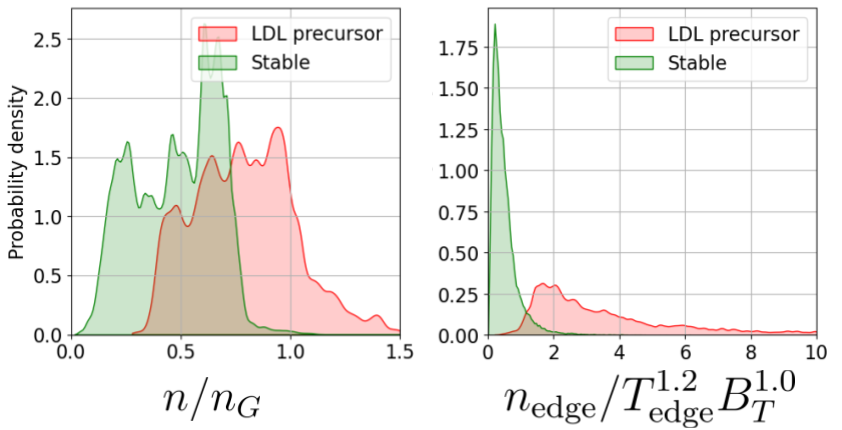The density of tokamak plasmas is a critical lever for fusion performance: fusion power density goes as \(n^2\), bootstrap current drive is enhanced by a higher density pedestal, and – of course – the Lawson Triple Product includes density. Currently, ITER and future power plants are designed to operate just below the Greenwald limit,
\[\frac{\bar{n}}{n_G} = 1\]where \(\bar{n}\) is the line-averaged density in \(10^{20}\) m\(^{-3}\), the Greenwald density is \(n_G \equiv I_p/\pi a^2\), \(I_p\) is the plasma current in MA, and \(a\) in the minor radius in meters. This empirical limit, first published in 1988 by PSFC Research Scientist Martin Greenwald, remains to this day the generally accepted rule of thumb for the density limit.
In this project, the team is investigating the reliability of the Greenwald limit as a measure of proximity to density limit instabilities and whether data-driven techniques could be used to identify a more accurate boundary that can be used for real-time control. At the moment, the team acknowledges that the Greenwald limit is not nearly reliable enough to be used for disruption prediction on ITER. Instead, a simple boundary in terms of the edge density, temperature, and toroidal magnetic field is able to achieve excellent density limit prediction performance (true positive rate of 94% for a false positive rate of 5%).

These findings were obtained by assembling a multi-machine database of AUG, C-Mod, DIII-D, and TCV L-mode density limit events. This database was enabled by the active collaboration in place between the PSFC Disruptions team and EPFL-SPC research scientist Dr. Alessandro Pau, who is in charge of the development of the EUROfusion Disruption Database.
Different algorithms, like a neural network (NN) and support vector machine (SVM), were trained on this problem to compare their predictive performance with that of the Greenwald fraction. Current results show that the Greenwald fraction achieves a true positive rate of 55% at a false positive rate of 5% on the test set, while the NN and SVM achieve 97% and 94% true positive rate, respectively. This large improvement improvement lies in the interpretable workflow enforced during the data-driven study. The trained SVM is exactly equivalent to the power law
\[n^{\textrm{(limit)}}_{\textrm{edge}} = 3 \cdot T^{1.2}_{\textrm{edge}} B_T^{1.0}\]where \(n^{\textrm{(limit)}}_{\textrm{edge}}\) [\(10^{20}\) m\(^{-3}\)] is the edge density limit leading to a L-mode density limit disruption, \(T_{\textrm{edge}}\) [keV] is the edge temperature, and \(B_T\) [T] is the toroidal magnetic field on axis. These three parameters on their own in a simple power law are able to form a reliable L-mode density limit boundary. This is a good sign for burning plasmas, where it is expected to have high edge temperatures due to self-heating and high magnetic fields relative to current devices. In the next phase of the project, the team plans to investigate the H-mode density limit and add new scenarios (such as negative triangularity L-mode) to the database.
The density-limit team is led by graduate student Andrew Maris (MIT NSE), with the close collaboration of Dr. Alessandro Pau, Research Scientist at EPFL-SPC. Andrew’s supervisors are Dr. Cristina Rea, Dr. Robert Granetz, and Dr. Earl Marmar.